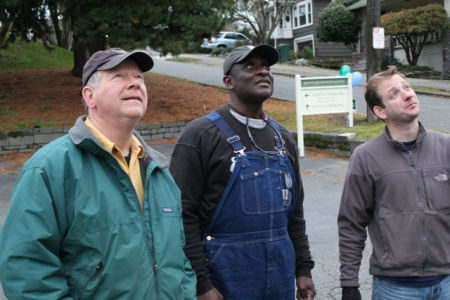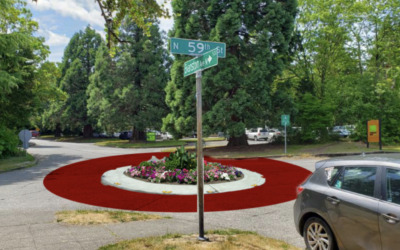One of the first two “passive houses” in Washington just went up for display at the Phinney Neighborhood Association (PNA) Saturday morning around 6.
This structure is called Mini-B, short for “mini-bungalow,” and is one of only “a handful in the country right now,” building designer and architect Joe Giampietro, a Ballard resident, said just after the structure arrived. “It’s a surging phenomenon in the Northwest with many more passive houses on the way.”

Mini-B “uses only 15 to 25 percent of the energy of what a current code house would use,” he explained.
Last year Giampietro, of Johnson Braund Design Group in Seattle, partnered with instructor Frank Mestemacher at Seattle Central Community College’s Wood Construction Center (SCCC) to build Mini-B.
“The whole process has been about a year,” Mestemacher, 66, from Whidbey Island, said. “But the building started about March when we began framing it.”
He was on site Saturday morning with five of his students, volunteering their time to temporarily install the structure until it can be lowered and secured from blocks onto the PNA parking lot for long-term display.
“We’re here because we want to learn,” SCCC carpentry student John Wilson, 37, said. The Ballard resident added, “This is just us being interested throughout the whole process.”

SCCC instructor Frank Mesemacher, with carpentry students Wordsworth Scott, 54, and John Wilson, 37, watch a fellow volunteer as he works on the roof of the Mini-B.
“You’ll see it here the way it could be seen in someone’s yard,” said Giampietro, who got up at 2 a.m. to prepare for the transport of Mini-B. “Today is a temporary setting, but it will be lowered and will eventually sit two feet off of the ground.”
He said the PNA agreed to host Mini-B for six months, and at that time it will go up for sale online for about “$70,000 to $80,000.”
“We approached the PNA three months ago, and they were delighted,” Giampietro said while keeping one eye on the students as they carefully placed the blocks that Mini-B now sits on. “It fits their mission of sustainable development.”
Giampietro added that a number of local businesses have jumped on board and donated their services and products to help build Mini-B, including Morgan Electric & Plumbing at 8055 15th Ave. NW and the Greenwood-Phinney Electric Co. at 139 NW 85th.
“They see this as a future-oriented building project, and they wanted to see their businesses associated with it,” he said.

Joe Giampietro (left) examines the Mini-B Passive House with Frank Mestemacher, as students from SCCC help place it on temporary posts in the parking lot of the Phinney Neighborhood Association.
Mini-B conforms to the International Residential Code in the State of Washington, which means you can put one of them in your back yard or even retrofit an existing structure with the same standard.
“So, you don’t have to tear down the whole house,” said Wilson, who hopes to start a career in carpentry after he graduates from the program. “You can make it ‘passive’ through retrofitting.”
Giampietro said it is approximately 300 square feet and features “lots of insulation, high-performance windows, airtight construction and heat-recovery ventilation.”
“The hardest problem was the care to details because the weatherization is so tight,” Mestemacher. said “But it has been a great learning experience for the students and me.”
Mini-B, unlike many new innovations, requires “no new technology,” Giampietro said. “It’s all available today, and all of the products can be purchased in the U.S. right now.”
In fact, Giampietro said passive house technology began in the 1970s and ‘80’s in the U.S. “but stopped because energy got cheap.”
“The Germans and Swedes picked it up,” he said. “It’s a growing phenomenon, and now there are around 20,000 in Europe.”
“I like the aspect of not losing energy,” Wilson said. “And if it means saving the people and the government more money, I’m all for it.”
“I’m an advocate for low-energy building as an architect, and I wanted to create a demonstration of how simple and affordable that can be,” Giampietro said. “I want people to go in and say, ‘Hey, this is a future that’s feasible to me.’”
He also said passive house building techniques are easier to use on large structures, and he estimates for an additional 5 to 10 percent in building costs, the average contractor can meet the standard.
“It’s not hard, and we don’t have to suffer from a reduction in a standard of living,” he added.
Tyler Steele is PhinneyWood’s intern. He is a journalism student at the University of Washington.




